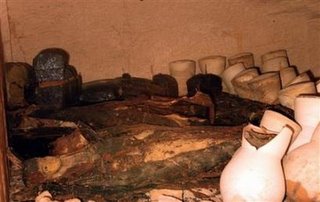

I'm usually opposed to using exclamation points in a headline, but in this case -- I just couldn't resist! My buddies know what a geek I am when it comes to Ancient Egypt and archaeology, so I know you'll forgive me if I ramble on for a second about how fricking exciting it is that they've found an unopened tomb in the Valley of the Kings in Egypt. An expedition from the Unversity of Memphis, Tennessee was working on a nearby tomb when they found indications that ancient workers had worked on the rock nearby. (Isn't archaeology amazing? They can tell where workers camped on bare rock thousands of years ago.) After weeks of digging right next to the tomb of King Tut, they found a sealed door to a shaft leading down to a previously unknown tomb.
Alas, the wheels of archaeology grind slowly. These scientists must be painstaking in recording every step as they essentially deconstruct and destroy what was created by people who lived, in this case, 3,000 years ago. 90 percent of what we learn from a site comes from context, so every tiny detail must be taken down in photos, drawings, written commentary, etc., because once taken apart, the context can nevery be recreated. The archaeologists in this case have not yet even entered the tomb. But we can see five sarcophogi, which probably contain mummies. The head of one woman is clearly visible, painted on her coffin. Another is in splinters due to termites. The style indicates that these were wealthy, influential people of the 18th dynasty court, possibly royal or favored courtiers. Only those at the highest levels would've been buried in the Valley of the Kings. Heiroglyphs on the coffins, once investigated, should reveal the identities of those buried in this tomb. The chamber appears to be only 12 by 15 feet, not a complex tomb like most of the royal ones in the Valley. My semi-educated guess would be that these mummies are not powerful members of the royal family, but rather favored friends of royalty, lesser relations, or high officials.
But you never know. Over the thousands of years of Egyptian history, priests and relatives moved bodies, even royal ones, from tomb to tomb, trying (and usually failing) to avoid robbers. The wealth buried with these bodies was just too tempting for even gods-fearing folk like the ancient Egyptians. Dynasties of robber families formed over the years, sharing secret locations and techniques for avoiding the pit traps and labyrinths of the more elaborate tombs. One member of a famous family of robbers even lead archaeologists in the 1800's to a large tomb filled with royal bodies -- after it had been picked clean of gold, of course. This more secret history of thievery is fascinating in and of itself.
So for now we Egypt geeks must watch and wait to see what has been found here. No spectacular gold piece, such as those in Tut's tomb, have yet come to light. But archaeologists can derive huge amounts of information from these mummies and the many jars they have been buried with. Who knows what else lurks beneath those piles of rotting wrappings and broken ceramic? This is the joy of archaeology -- the element of surprise. You never know what treasure you might find. Folks at the University of Memphis found a doozy this time.
No comments:
Post a Comment